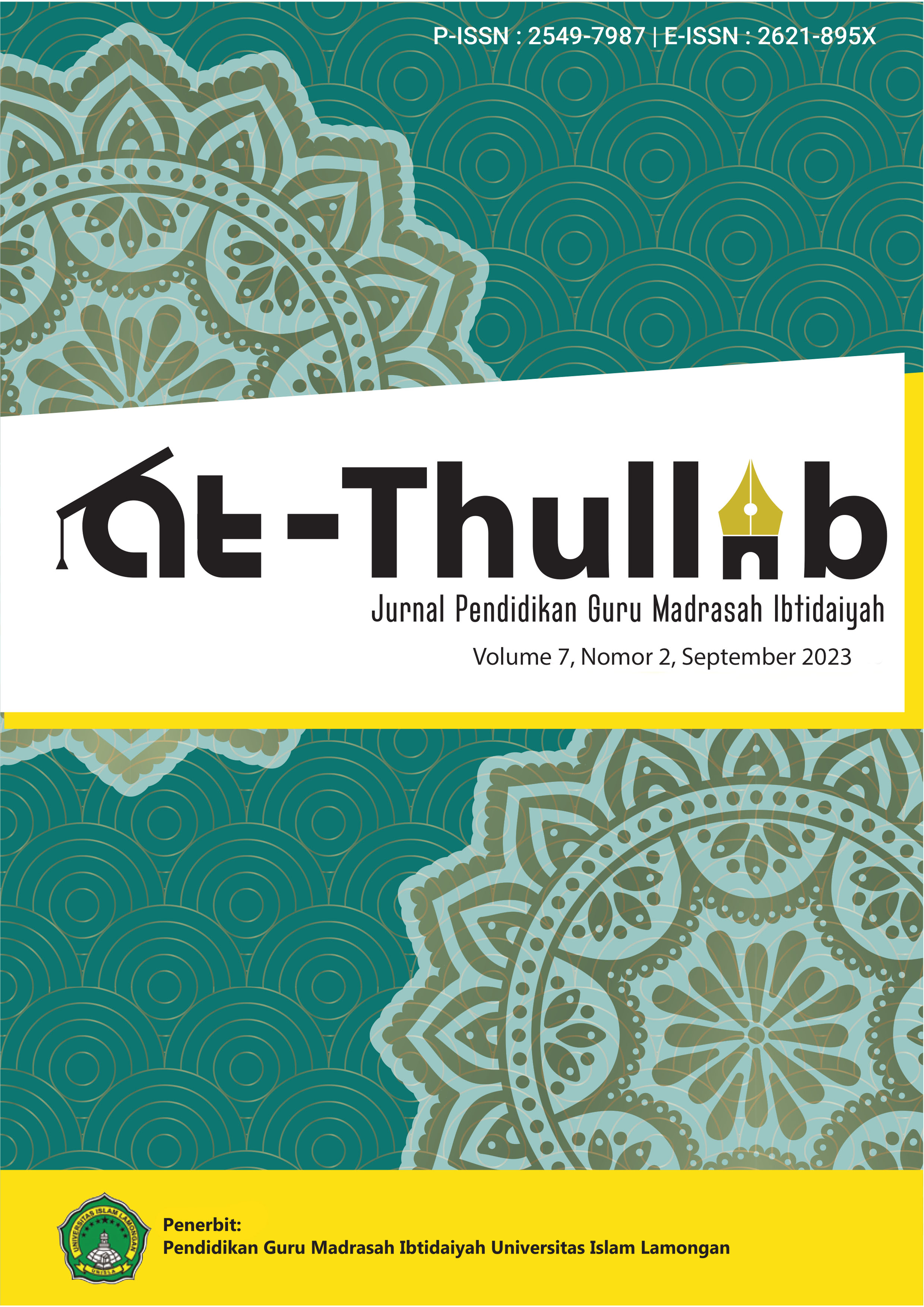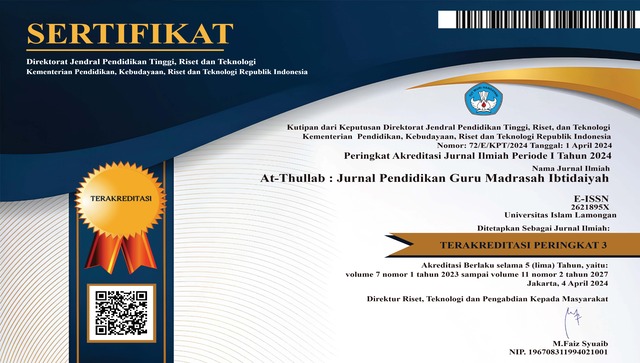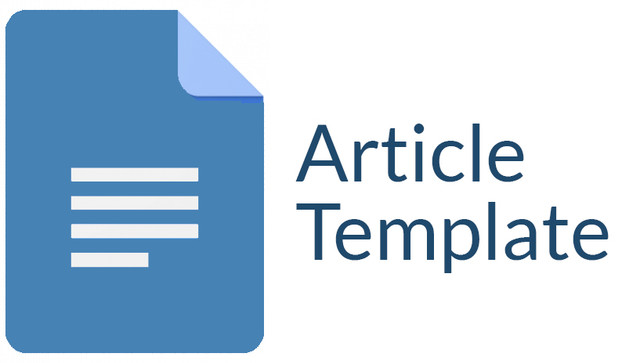Pengembangan e-Modul Bilangan Berbasis Somatic, Auditory, Visual, Intelektual (SAVI) untuk Meningkatkan Literasi Numerasi Siswa Sekolah Dasar
DOI:
https://doi.org/10.30736/atl.v7i2.1425Keywords:
E-modul Bilangan, Pendekatan SAVI, Literasi Numerasi.Abstract
Abstrak: Perkembangan teknologi dan komunikasi yang semakin pesat, menjadikan guru SD mulai tertarik untuk menggunakan e-modul dalam pembelajarannya. Namun e-modul yang digunakan belum dikembangkan pada pendekatan pembelajaran yang menekankan pada literasi numerasi. Tujuan penelitian ini adalah mendeskripsikan kevalidan, kepraktisan dan keefektifan dari e-modul bilangan berbasis somatic, auditory, visual, intellectual (SAVI) untuk meningkatkan literasi numerasi siswa Sekolah Dasar. Desain penelitian ini menerapkan model Dick and Carey yang direkomendasikan oleh Borg and Gall. Hasil penilaian validator terhadap e-modul pada kategori sangat layak pada aspek media, materi dan bahasa. Sedangkan data kemenarikan e-modul siswa memperoleh persentase 95,8% dengan berkategori sangat baik. Nilai matematika siswa tertinggi (maksimum) adalah 90, sedangkan nilai terendah (minimum) adalah 80. E-modul pembelajaran berbasis somatic, auditory, visual, intellectual (SAVI) masuk dalam kategori “Efektifâ€. Berdasarkan hal tersebut e-modul layak digunakan.
Abstract: The rapid development of technology and communication has interested elementary school teachers in using e-modules in their learning. However, the e-modules used have yet to be developed on a student-centered learning approach and numeracy literacy. This research aims to describe the validity, practicality, and effectiveness of somatic, auditory, visual, and intellectual (SAVI) based number e-modules to improve numeracy literacy of elementary school students. This research design applies the Dick and Carey model recommended by Borg and Gall. The results of the validator's assessment of the e-module in the very feasible category in media, material, and language. In contrast, the data on the students' e-module attractiveness obtained a percentage of 95.8% with a very good category. The highest (maximum) student learning outcome score was 90, while the lowest (minimum) score was 80. The somatic, auditory, visual, and intellectual (SAVI) based learning e-module falls into the "Effective" category. Based on this, the e-module is suitable for use.Downloads
References
Ate, D., & Lede, Y. K. (2022). Analisis Kemampuan Siswa Kelas VIII dalam Menyelesaikan Soal Literasi Numerasi. Jurnal Cendekia : Jurnal Pendidikan Matematika, 6(1), 472–483. https://doi.org/10.31004/cendekia.v6i1.1041
Gall, M. D., Gall, J. P., & Borg, W. R. (2003). Meredith D. Gall, Walter R. Borg, Joyce P. Gall - Educational Research_ An Introduction (7th Edition)-Allyn & Bacon (2003).pdf (pp. 569–575).
Han, W., Susanto, D., Dewayan, Sofie , S.T. Nur Pandora, Hanifah, P., Miftahussururi, Nento, M. N., & Akbari, Q. S. (2017). Materi Pendukung Literasi Numerasi [Numeracy Literacy Support Materials]. Kementerian Pendidikan Dan Kebudayaan [Ministry of Education and Culture].
Hidayati Azkiya, M. Tamrin, Arlina Yuza, & Ade Sri Madona. (2022). Pengembangan E-Modul Berbasis Nilai-Nilai Pendidikan Multikultural di Sekolah Dasar Islam. Jurnal Pendidikan Agama Islam Al-Thariqah, 7(2), 409–427. https://doi.org/10.25299/al-thariqah.2022.vol7(2).10851
Kencanawati, S. A. M. M., Sariyasa, S., & Hartawan, I. G. N. Y. (2020). Pengaruh penerapan model pembelajaran SAVI (Somatic, Auditory, Visual, Intellectual) terhadap kemampuan berpikir kreatif matematis. Pythagoras: Jurnal Pendidikan Matematika, 15(1), 13–23. https://doi.org/10.21831/pg.v15i1.33006
Kusumam, A., Mukhidin, M., & Hasan, B. (2016). Pengembangan Bahan Ajar Mata Pelajaran Dasar dan Pengukuran Listrik untuk Sekolah Menengah Kejuruan. Jurnal Pendidikan Teknologi Dan Kejuruan, 23(1), 28. https://doi.org/10.21831/jptk.v23i1.9352
Kusumaningsih, W., Sutrisno, S., & Hidayah, F. (2019). Efektivitas Model Pembelajaran Savi dan React Berbantuan LKS terhadap Kemampuan Komunikasi Matematis Siswa SMP. Journal of Medives : Journal of Mathematics Education IKIP Veteran Semarang, 3(2), 197. https://doi.org/10.31331/medivesveteran.v3i2.763
Laili, I., Ganefri, & Usmeldi. (2019). Efektivitas Pengembangan E-Modul Project Based Learning Pada Mata Pelajaran Instalasi. Jurnal Imiah Pendidikan Dan Pembelajaran, 3, 308.
Nisa, A. H., Mujib, M., & Putra, R. W. Y. (2020). Efektivitas E-Modul dengan Flip Pdf Professional Berbasis Gamifikasi Terhadap Siswa SMP. Jurnal Pendidikan Matematika Raflesia, 05(02), 14–25. https://doi.org/https://doi.org/10.33369/jpmr.v5i2.11406
Nisrina, S. H., Rokhmawati, R., & Afirianto, T. (2021). Pengembangan E-modul Berbasis Project Based Learning ( PjBL ) pada Mata. Edu Komputika Journal, 8(08), 82–90. https://doi.org/https://doi.org/10.15294/edukomputika.v8i2.48451
OECD. (2019). PISA 2018 Assessment and Analytical Framework. OECD Publishing. https://doi.org/https://doi.org/10.1787/b25efab8-en
Ojose, B. (2011). Mathematics literacy : are we able to put the mathematics we learn into everyday use? Journal of Mathematics Education, 4(1), 89–100.
Sugihartini, N., & Jayanta, N. L. (2017). Pengembangan E-Modul Mata Kuliah Strategi Pembelajaran. Jurnal Pendidikan Teknologi Dan Kejuruan, 14(2), 221–230. https://doi.org/10.23887/jptk-undiksha.v14i2.11830
Sutarna, N. (2018). Pengaruh Model Pembelajaran Savi (Somatic Auditory Visual Intellectualy) Terhadap Hasil Belajar Siswa Kelas Iv Sekolah Dasar. Profesi Pendidikan Dasar, 1(2), 119. https://doi.org/10.23917/ppd.v1i2.6068
Tohir, M., Abidin, Z., Dafik, D., & Hobri, H. (2018). Students creative thinking skills in solving two dimensional arithmetic series through research-based learning. Journal of Physics: Conference Series, 1008(1). https://doi.org/10.1088/1742-6596/1008/1/012072
Downloads
Additional Files
Published
How to Cite
Issue
Section
License
Authors who publish with this journal agree to the following terms:
The journal allow the authors to hold the copyright without restrictions and allow the authors to retain publishing rights without restrictions. Authors retain copyright and grant the journal right of first publication with the work simultaneously licensed under a Creative Commons Attribution-ShareAlike 4.0 International License. that allows others to share the work with an acknowledgement of the work's authorship and initial publication in this journal.
Authors are able to enter into separate, additional contractual arrangements for the non-exclusive distribution of the journal's published version of the work (e.g., post it to an institutional repository or publish it in a book), with an acknowledgement of its initial publication in this journal.
Authors are permitted and encouraged to post their work online (e.g., in institutional repositories or on their website) prior to and during the submission process, as it can lead to productive exchanges, as well as earlier and greater citation of published work (See The Effect of Open Access).
The journal allows third parties (readers, researchers, and others) to share and adapt the material in line with the license. In addition, the material must be given appropriate credit, provided with a link to the license, and indicate if changes were made. If authors remix, transform, or build upon the material, they must distribute their contributions under the same license as the original.













